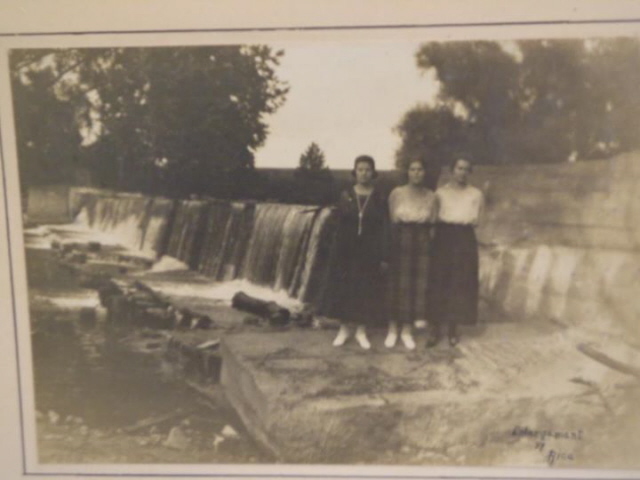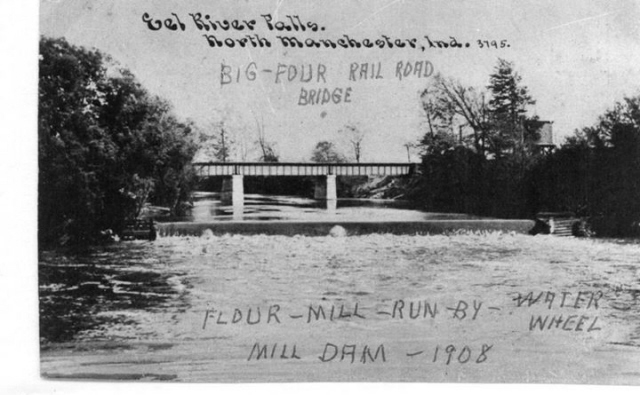|
MILLS
Source: CFH files,
May 2, 1940 manuscript
North Manchester had no
flour mill in 1836 when the town was founded, nor does
it have one today, but in between, the milling industry
in the town had an important part in the growth of the
community and of North Manchester as a trading center.
Today the only reminder that a once busy business
existed in the southwest part of town is the dam in Eel
River. Traces of the old mill site and the mill race are
almost obliterated. As mentioned in the story of the
Stockdale Mill, Peter Ogan had built a dam just below
the present covered bridge, dug a channel for a mill
race across the neck of land caused by the curve in the
river, and operated a grist mill for a number of years.
His brother, John Ogan had a corn cracker mill on Pony
Creek along Road 113. The mill was south of the present
channel of the creek.
Shortly after Joseph Harter and his
married son, Eli, came to North Manchester, the elder
Mr. Harter bought land from Daniel Stone in what is now
the southwest part of North Manchester, the transfer of
title being made November 16, 1836, about a year after
Mr. Stone obtained the land at the government land
office in Fort Wayne. Mr. Harter also bought land from
George W. Hatch in the same vicinity, owning in all
about 200 acres.
In 1839, Mr. Harter and his son,
Eli, built a dam across Eel River and started in the
milling business. The dam was constructed of stone,
brush, and earth and was several rods below the present
dam. In 1843, Mr. Harter built a larger mill with three
runs of buhrs. Eli in the meantime had bought a farm
west of North Manchester and ceased to be a factor in
the development of North Manchester.
The 1843 mill was able to grind a
superior grade of flour and the business flourished. In
the water power mills, the water wheel was in a
perpendicular position. The shaft extended upward
through the lower mill stone and was fastened to the
upper stone. The stones were circular and of a peculiar
quality with some corrugation. The lower stone revolved,
the upper stone was stationary. The grain was ground
between the stones and by successive grinding by the
different runs of buhrs, the finer portion of the grain
became flour, while the coarser portions were classed as
bran and middlings. The lower part of the shaft, which
was down in the water, revolved on a hard wood bearing
known as lignum vitae, one of the most durable woods
known. As the water flowed from above the dam through
the mill race, it turned the mill wheel and then
returned to the river below the mill.
Joseph Harter, Sr., operated the
mill until 1851 when he turned it to his sons, Jacob and
Joseph B. Harter, who were familiarly known as J. and
J.B. Harter, in their long association together in
business. The Harter brothers only operated the mill a
short time and sold it to Peter King, February 12, 1852.
King only owned the mill two years and then sold it to
Isaac Thorn who operated it until 1872. He then sold it
to Conner and Jacob Tilman for $7,000.
It was while the Harters owned the
mill that Peter Ogan brought a damage suit, charging
that his water power was endangered because the Harter
dam was backing water up to his dam. The suit dragged
through the courts for a number of years while the case
dragged in the court. Peter Ogan disposed of his
interest in the mill site to his brother, John. The
Harters had sold their interest and by the time the case
reached the supreme court on appeal, John Ogan had died
during the Civil War years. The administrator of his
estate also went into the Union Army and in the end,
Mrs. Ogan sold her interest in the mill site to the
Harter mill owners.
The Harter mill was bought in 1879
by Henry Arnold and Daniel Strauss, the latter the
grandfather of Arden Strauss. Two brothers, Daniel and
Jacob Struass, came to Laketon after the Civil War. They
and another brother, Adam, learned the miller’s trade in
Chicago. Jacob Strauss was active in the milling
business at Laketon, and Adam was in the milling
business at Huntington. Jacob later changed the spelling
of his name to “Strouse.”
Arnold and Strauss immediately
started construction of a new mill building and a new
dam several rods upstream from the Harter dam. Later
this dam was rebuilt and is the one existing today. The
mill building served until it was destroyed by fire in
1928.
Successive firms operated the mill
in the later years. Daniel Strauss sold his interest to
two sons, J.W. and Ervin Strauss in 1888, and Ervin sold
his interest to his brother in 1893. Isaac Shock and
Charles M. Rudy had an interest in the mill for several
years and they sold to Samuel Hamilton in 1884.
Apparently this was a one-third interest. Other part
owners in succeeding years were Jesse J. Tyler, David
Hamilton, A.D. and I.E. Gingerick, and others. During
those years the milling firm also maintained an uptown
feed store.
In 1906, David Hamilton sold his
interest to John Isenbarger and about that time J.W.
Strauss disposed of his interest and opened a new feed
store and feed mill uptown. This business is now
operated by the son, Arden, and a grandson, Donald. The
Strauss competition eventually caused the milling firm
to close its uptown store.
Later part owners were Noah Garber
and Allen Dohner, who had been connected with the
Laketon mill prior to coming to North Manchester. In
1920, a stock company was organized and incorporated.
Stockholders included Paul and Bland Isenbarger, A.B.
Palmer, W.S. Humke, Daniel Sheller, Henry Reiff, William
Jennings, George Allen, Dr. George L. Shoemaker, J.K.
Lautzenhiser & Company, F.P. Kircher, Frank Reelhorn,
Cora M. Reelhorn, W.C. West, J.H. Miller, H.B.
Lautzenhiser, A.P. Bolinger, E.W. Gresso, and Hugh L.
Kennedy.
In 1922, Cade King bought the
business and the mill burned June 2, 1923. A
receivership action brought by some of the former
stockholders was halted when Mr. King paid his
indebtedness to them, and he reorganized a company
including himself, Mrs. King, Hugh Miller and Samuel F.
Bowen. The mill building was rebuilt, but unable to meet
obligations, it passed into the control of a Warsaw bank
in 1927, and in 1929, was bought by the Northern Indiana
Poser Company. The mill building was dismantled and
moved away. The Power Company bought it to prevent the
site from being used to generate electricity, as was
being done on a limited scale at Liberty Mills and
Collamer.
After possession of several years,
the Electric Company gave the mill site, which includes
about four acres of land, to the Town of North
Manchester with the condition it could never be used as
a site to generate electricity. Part of this land is now
occupied by the Heinold Hog Market by lease, and it may
become the site of a sewage disposal plant if and when
North Manchester builds one.
**************************************
SESQUICENTENNIAL HISTORICAL
REPORT, The News-Journal, Monday, June 17,
1985
[Photo of The Grist Mill]
From the early 1840’s, the mill was
operated by the Harters, later by Daniel Strauss. At the
time of the picture (1917), the mill was operated by
Cade Ring.
The early stones and water wheel
were replaced by a cast iron turbine in 1863 which later
was replaced by an improved model. The mill burned in
1923.
The shadow in the picture is of the
railroad bridge across the river. The roadway is marked
“Hoosier Dixie” and is said to be the first marked
highway in America reaching from Detroit to Miami,
Florida. Later named Wabash Road, it brought a stream of
travelers through North Manchester.
***************************************
The News-Journal, Monday, June
24, 1985.
THE DAM AT THE MILLSITE ON
WABASH ROAD
Photo of Dam Site.
About 1840 the Harters moved their
grain grinding operation from Peter Ogan’s mill at the
foot of Mill Street to a new location on the Eel River.
The present dam is the second here. It was built by
first digging a race to divert the water. Next trees
were felled into the river. Logs, brush, stones, and
dirt made a solid barrier over which the water flowed.
Much later cement facings and aprons were guilt. The
race gates were opened or shut to control the flow of
water operating the water wheel and grinding stones, and
later the turbines in the mill. When the river caught
fire after a train wreck, the dam kept the conflagration
from extending into the town.
EDITOR’S NOTE: In anticipation of
North Manchester’s Sesquicentennial Celebration during
1986, the News-Journal, in cooperation with the North
Manchester Historical Society, is presenting vignettes
from the community’s past. All of the pictures are
original postcards of the town.
Mill Dam circa 1920:


|